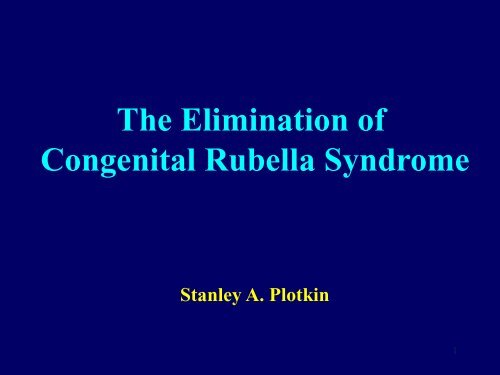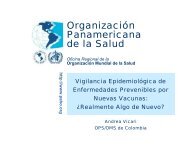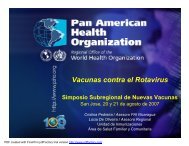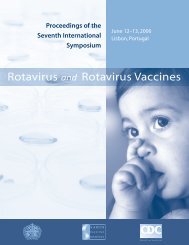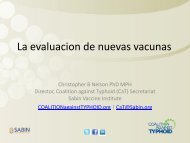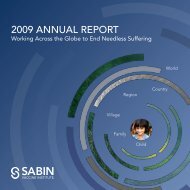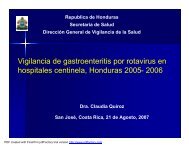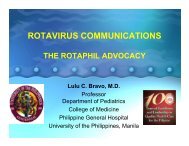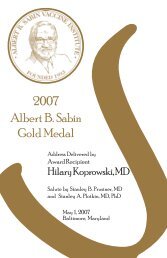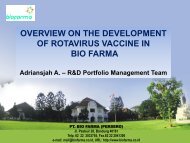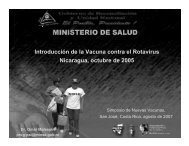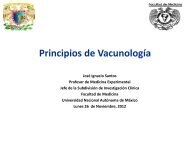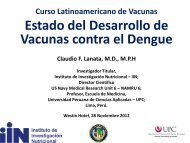Stanley Plotkin - Sabin Vaccine Institute
Stanley Plotkin - Sabin Vaccine Institute
Stanley Plotkin - Sabin Vaccine Institute
Create successful ePaper yourself
Turn your PDF publications into a flip-book with our unique Google optimized e-Paper software.
The Elimination of<br />
Congenital Rubella Syndrome<br />
<strong>Stanley</strong> A. <strong>Plotkin</strong><br />
Second FINALRubella Rome 2012<br />
2/23/2012 12:52 PM<br />
1
Current Manufacturers of Rubella <strong>Vaccine</strong>s<br />
Manufacturer Virus Strain Cell Substrate<br />
Merck (United States) RA27/3 HDCS<br />
Glaxo SmithKline-RIT (Belgium) RA27/3 HDCS<br />
Crucell (Switzerland) RA27/3 HDCS<br />
Sanofi Pasteur (France) RA27/3 HDCS<br />
Novartis (Italy) RA27/3 HDCS<br />
<strong>Institute</strong> of Immunology (Yugoslavia) RA27/3 HDCS<br />
Serum <strong>Institute</strong> of India RA27/3 HDCS<br />
Kitasato <strong>Institute</strong> (Japan) Takahashi Rabbit kidney<br />
Biken (Japan) Matsuura Quail embryo fibroblast<br />
Takeda Chemical Industries (Japan) TO-336 Rabbit kidney<br />
BRD-2 (China)<br />
HDCS<br />
HDCS, human diploid cell strain.<br />
Modified from Perkins FT. Licensed vaccines.<br />
Rev Infect Dis 7:S73–S76, 1985.<br />
2
Origin of RA/27/3 Rubella <strong>Vaccine</strong><br />
In 1964, many women in US infected<br />
during pregnancy.<br />
My laboratory diagnosed many cases,<br />
and received aborted fetuses for study<br />
One of those was selected for isolation of<br />
viruses for attenuation<br />
3
Choice of Substrate<br />
Rubella virus will grow in human, monkey<br />
and rabbit cells.<br />
However, I wished to avoid contaminants.<br />
I chose to use the WI-38 human fetal fibroblast<br />
cell strains developed at The Wistar Inst.<br />
This cell was cultured from one fetus, from<br />
which cells were expanded exponentially<br />
by passage in vitro.<br />
Cells stored frozen at 12 th passage can be<br />
expanded to 30 th passage, after which<br />
they become senescent.<br />
4
Attenuation of RA 27/3<br />
Isolated from fetal kidney explant<br />
Grown in WI-38 Human fetal fibroblasts<br />
Passaged in WI-38 4X by cell to cell<br />
contact at 35C<br />
Passage of supernatant virus 4 X at 35C<br />
Subsequent passages at 33C, then 30C<br />
with 4 terminal dilutions until passage 25<br />
Changes in in vitro markers<br />
5
Changes in Markers<br />
with Passage of RA27/3<br />
Markers<br />
Passage<br />
BHK Nt Ab Rash Pharyng<br />
level rct 30C plaques induction induction Excr.<br />
20 + + + – +/-<br />
6
Rubella <strong>Vaccine</strong>, Live<br />
RA 27/3 Strain<br />
Isolated from rubella-infected fetus<br />
Attenuated in human fibroblast cells<br />
Cold-adapted mutant<br />
Immunogenic by the subcutaneous,<br />
intramuscular, intranasal and aerosol routes<br />
Used since 1960s<br />
Administered with measles and mumps<br />
vaccines 9-15 months of age<br />
7
Viremia and Virus Excretion in Volunteers<br />
After Subcutaneous or Intranasal Challenge<br />
with RA27/3 Rubella Virus <strong>Vaccine</strong><br />
Antibody Status<br />
Before Vaccination No. of <strong>Vaccine</strong>es Viremia Virus Excretion<br />
Seronegative 21 15 12 (6–14)*<br />
Seropositive (>15 IU) 10 0 1 (7)<br />
Low titer (£15 IU)<br />
Natural infection 12 0 0<br />
Previous vaccination<br />
RA27/3 7 0 0<br />
Other strains 12 1 (12) 3 (6–9)<br />
*<br />
Numbers in parentheses indicate days after vaccination on which findings were positive.<br />
Adapted from O’Shea S, Best J, Banatvala JE. Viremia, virus excretion,<br />
and antibody responses after challenge to volunteers with low levels of<br />
antibody to rubella virus. J Infect Dis 148:639–647, 1983.<br />
8
<strong>Plotkin</strong> SA, et al. Rev Infect Dis 7(suppl):S77-S89, 1985<br />
9
Long-term persistence of rubella antibodies<br />
after vaccination with the RA27/3 strain.<br />
References<br />
Country where<br />
study carried<br />
out<br />
Years after<br />
vaccination<br />
(number of<br />
doses)<br />
No. Seropositive/no.<br />
tested (%)<br />
Serological<br />
method used<br />
Christenson & Bottiger, Sweden 16 (1) 184/190 (96.8%) HI<br />
1994<br />
Enders & Nickerl, 1988 Germany 14 (1) 115/115 (100%) HI<br />
Hillary & Griffith, 1988 Ireland 15 (1) 20/21 (93.3%) HI<br />
Horstmann et al. 1985<br />
USA 11-12 (1) 35/35 (100%) NT<br />
33/35 (95%)<br />
HI<br />
O’Shea et al. 1988 UK 10-21 (1) 47/48 (97.9%) SRH, EIA,<br />
latex aggl.<br />
Zeally & Edmond UK 12 (1) 93/94 (99%) SSRH<br />
<strong>Plotkin</strong> & Buser, 1985 USA 12-14 (1) 29/29 (100%) HI<br />
Johnson et al. 1996 USA 10-12 (1) 36/57 (63%) NT<br />
Kremer et al, 2000 Luxemburg 7(1) 1224 (92%) EIA<br />
Vandermeulen et al, 2007 Netherlands 8 (2) 119/119 (100%) EIA<br />
Davidikin et al, 2008 Finland 20 (2) 275/275 (100%) EIA<br />
LeBaron et al, 2009 USA 7-12 (2) 521/613 (85%) NT<br />
Kakowliden et al, 2010 Sweden 22 (2) 1707/1870 (91%) EIA<br />
10
Rubella seronegative rates with 95% CI for primiparous women,<br />
9 to 22 years after vaccination in the third grade of junior high school<br />
(at 15 years of age) in Taiwan<br />
Lin CC, et al. Clin Vacc Immunol, 2012; 19(1):1-4<br />
11
Furukawa T,. et al. JAMA 213:987-990, 1970<br />
12
Protective Efficacy against Rubella Disease<br />
Afforded by Rubella <strong>Vaccine</strong>s RA27/3 During<br />
Rubella Outbreaks<br />
(adapted from <strong>Plotkin</strong> & Reef 2004)<br />
Reference Population studied No. <strong>Vaccine</strong>es<br />
exposed<br />
Protective<br />
efficacy<br />
Beasley et al. 1969 Primary schools, China 198 99.5%<br />
Furukawa et al. 1969 Boys’ school, Japan 24 100%<br />
de Valk & Rebiere, 1998 Primary school, France 119 95%<br />
Greaves et al. 1983 High school children, USA >600 90%<br />
Davis et al. 1971 Institution USA 22 100%<br />
13
Target Groups for Rubella Vaccination<br />
Infants 12 mo (could be down to 6 mo)<br />
Older unvaccinated children and adolescents<br />
College students<br />
Childcare personnel<br />
Health care workers<br />
Military personnel<br />
Adult women before pregnancy<br />
Adult seronegative women postpartum<br />
Adult men in contact with pregnant women<br />
All of the above as part of a two-dose elimination strategy<br />
14
Symptoms and Signs Caused by MMR Vaccination and<br />
Day of Peak Occurrence in Finnish Twin Study<br />
Symptoms and Signs Maximum 95% CI Peak Frequency<br />
Difference in<br />
(Days After<br />
Rate*<br />
Vaccination)<br />
Local erythema (>2 cm) 0.8 0.1–1.4 2<br />
Other local reaction 0.4 0–1.4 2<br />
Mild fever (£38.5°C rectal) 2.7 0–6.1 10<br />
Moderate fever (38.6–39.5°C) 2.9 1.6–4.3 9<br />
High fever (³39.5°C) 1.4 0.7–2.1 10<br />
Irritability 4.1 2.1–6.1 10<br />
Drowsiness 2.5 1.4–3.6 11<br />
Willingness to stay in bed 1.4 0.5–2.3 11<br />
Generalized rash 1.6 0–3.0 11<br />
Conjunctivitis 2.1 0.9–3.2 10<br />
Arthropathy 0.8 0.2–1.3 7–9<br />
Peripheral tremor 0.4 0–0.9 9<br />
Cough and/or coryza -1.5 † -4.6–1.6 9<br />
Nausea and/or vomiting -0.8 † -1.6–0 7–8<br />
Diarrhea 0.7 0–1.7 11<br />
*Between MMR group and placebo group.<br />
†More in placebo-injected children.<br />
From Peltola H, Heinonen OP. Frequency of true adverse reactions to measles-mumps-rubella vaccine: a double-blind placebo-controlled<br />
trial in twins. Lancet 1:939–942, 1986, with permission.<br />
15
Frequencies of Acute and Chronic Reactions to<br />
Rubella <strong>Vaccine</strong> or Placebo in Adult Women<br />
Group (%)<br />
Placebo (N = 275) <strong>Vaccine</strong> (N = 268) Odds Ratio<br />
(95% CI)<br />
Acute Reactions<br />
Sore throat 32 34 1.09 (0.75–1.59)<br />
Lymphadenopathy 10 19 2.21 (1.31–3.76)<br />
Rash 11 25 2.57 (1.58–4.21)<br />
Myalgia 16 21 1.36 (0.88–2.10)<br />
Paresthesias 7 7 1.09 (0.57–2.09)<br />
Arthralgia 16 21 1.42 (0.92–2.19)<br />
Arthritis 4 9 2.36 (1.13–4.92)<br />
Arthralgia or arthritis 20 30 1.73 (1.17–2.57)<br />
Adapted from Tingle A, Mitchell L, Grace M, et al. Randomised doubleblind<br />
placebo-controlled study on adverse effects of rubella immunisation<br />
in seronegative women. Lancet 349:1277–1281, 1996.<br />
16
Summary of Data on Accidental Vaccination Before Pregnancy and<br />
During Early Pregnancy of Women in the United States and Germany<br />
Vaccination of Unknowingly Pregnant Rubella Susceptible Women<br />
Country<br />
Live births to women receiving rubella immunization<br />
Within 3 months before<br />
conception or during<br />
pregnancy<br />
Laboratory<br />
Evidence of Infection<br />
Abnormalities compatible with<br />
CRS <br />
USA 324 + 6/222 (2.7%) 0/324<br />
Germany (West<br />
BRD)<br />
280 + 3/69 (4.3%) 0/279<br />
Sweden 5 + NK 0/5<br />
U.K. 71 + 4/52 (7.7%) 0/71<br />
Brazil 1647 * 67/1647 (4.1%) 0/1647<br />
Ecuador 43 * 2/43 (5%) 0/43<br />
El Salvador 59 * 1/59 (1.6%) 0/59<br />
Paraguay 119 * 0/119 0/119<br />
Iran 117 ¥ 0/117<br />
Costa Rica 93 * 0/93 (0%) 0/93<br />
Mexico 175€ 0/174 0/174<br />
Total 2933# 83/2478 (3.3 %) 0/2931<br />
#<br />
Confirmed susceptibles; actual number much higher.<br />
17
Contraindications and Precautions for MMR<br />
Prior allergic reaction to vaccine<br />
Severe immunodeficiency or immunosuppression<br />
Prior thrombocytopenia<br />
Pregnancy<br />
18
Status of Rubella and Vaccination<br />
Elimination Achieved:<br />
Scandinavia<br />
USA, Canada<br />
Caribbean<br />
Latin America<br />
Elimination set as goal:<br />
Western Europe<br />
Control Starting:<br />
Eastern Europe<br />
Middle East<br />
19<br />
Japan, Malaysia, Korea, Thailand
US Strategy for Rubella Elimination<br />
Universal vaccination with MMR<br />
at 12 - 15 months<br />
Catch-up vaccination of adolescents<br />
Vaccination of adult women at<br />
gynecological visits or post-partum<br />
20
Reported congenital rubella syndrome, United States,<br />
1970-1985<br />
History of <strong>Vaccine</strong> Development, <strong>Plotkin</strong> SA, ed. Springer, 2011:228<br />
21
Immunization Newsletter PAHO Vol. XXIX, no. 3, June 2007, page 1.<br />
22
Seropositivity and <strong>Vaccine</strong> Coverage<br />
Pebody RG et al. Epidemiol Infect. 125:347-357, 2000<br />
23
Seropositivity and <strong>Vaccine</strong> Coverage<br />
Pebody RG et al. Epidemiol Infect. 125:347-357, 2000<br />
24
Ukkonen P. Scand J Infect Dis 28:31-35, 1996<br />
Incidence of Rubella and Coverage in Finland<br />
25
Impediments to<br />
Rubella/CRS Elimination<br />
1) Cost of vaccine – $.25 -.50 per dose<br />
2) Inapparent rubella – but rash present in 60-70%<br />
3) Difficult surveillance of CRS –<br />
but screen for neonatal cataracts<br />
4) Concern regarding paradoxical enhancement<br />
of susceptibility of pregnant women.<br />
26
Rubella <strong>Vaccine</strong> Use by WHO Region,<br />
1996 vs. 2009<br />
Region 1996<br />
No. of countries (%)<br />
2009<br />
No. of countries (%)<br />
AFR 2 (4%) 2 (4%)<br />
AMR 21 (60%) 35 (100%)<br />
EMR 9 (43%) AMR<br />
EUR 39 (74%) 53 (100%)<br />
SEAR 2 (20%) 4 (36%)<br />
WPR 10 (37%) 21 (78%)<br />
Global 83 (43%) 130 (67%)<br />
28
WHO Regions by Rubella/CRS Control<br />
Target (2011)<br />
EUR-Rubella<br />
Elimination 2015<br />
AMR-<br />
Rubella<br />
Eliminati<br />
on<br />
2010<br />
AFR –<br />
No Goal<br />
EMR-National<br />
CRS Prevention<br />
WPR-<br />
Accelerated<br />
Rubella<br />
Control<br />
and CRS<br />
Prevention<br />
SEAR-<br />
No Goal<br />
29
Requirements for Eradication<br />
Polio Measles Rubella<br />
Animal reservoir 0 0 0<br />
Human reservoir + 0 0*<br />
Clinically apparent ± +++ ++<br />
Effective vaccine +/++/+++ +++ +++<br />
Coverage required ? 95% 80%<br />
*Transient in CRS<br />
30


